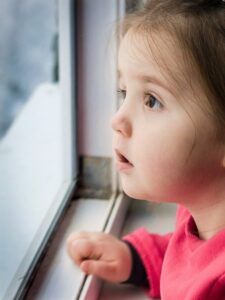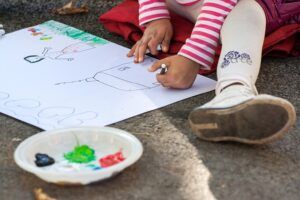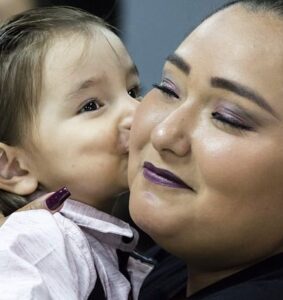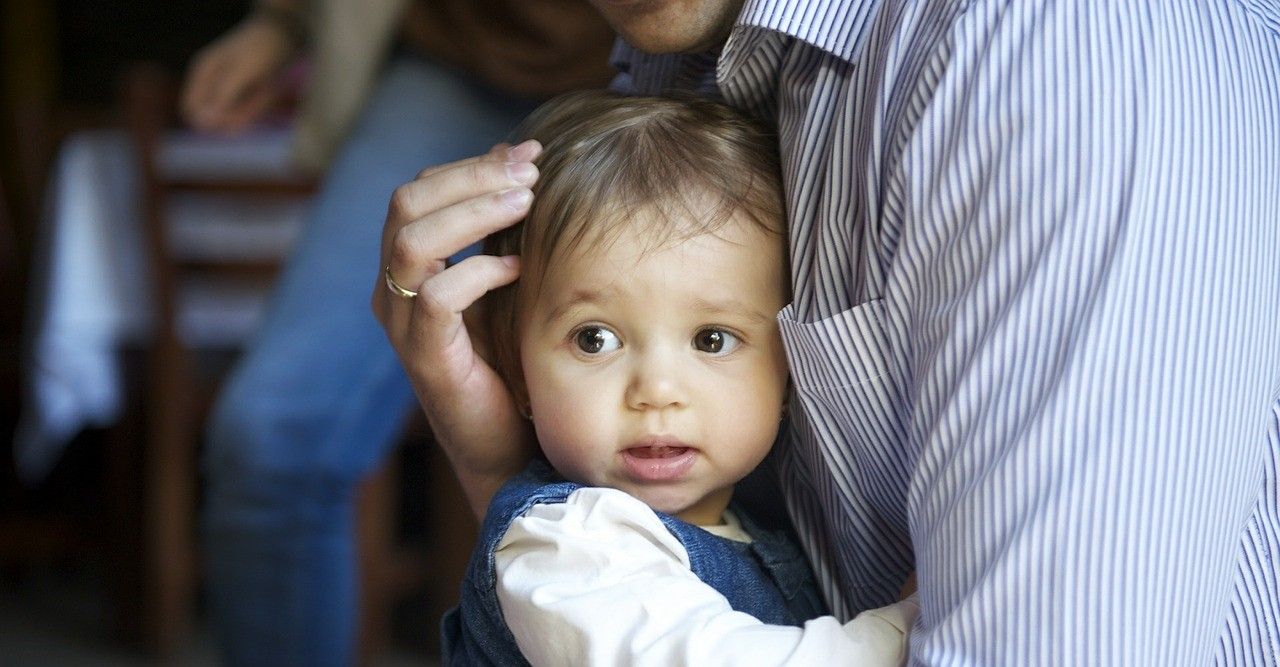It can be hard to know what to do and say after a scary and/or traumatic event, and how to explain it to your child. Our parent educator, Janice, offers the following helpful perspective:
“Mommy, why are you crying?” Sam, my four-year-old looked scared and anxious.
It was September 12, 2001 and, like everyone else in the world, I was trying to understand what happened the day before—what I witnessed on my television and how sad and frightened I was feeling. At age 33, I wondered when my own mom would be able to safely fly home, as well as what this horrific tragedy meant for our country and world.
I was feeling scared and anxious.
As parents and caregivers, it is important to reflect on our own well-being when we think about how our children are doing. Just as an infant develops attachment and self-regulation within the context of a caring relationship with a parent or caregiver, our children can learn how to cope and identify and process feelings within the care and context of supportive adults. That day in 2001, I needed to process my own emotions so that I could be present to support my son. Simply put, Sam was looking to me with the questions of a four-year-old and needed to know if I was going to be okay so that he could know he was okay.
Today we are faced with events that remind me of that time. Not only are we faced with civil conflict and images of violence on television, but our country is also experiencing a global pandemic that has affected all of us in one way or another. The layers of fear we are navigating can be overwhelming and our children are along for the ride.
One of the first things I learned in 2001 was to limit exposure to breaking news. I highly value being an informed citizen, but I also recognize that the constant avalanche of news has a negative effect on my well-being. Finding balance and limiting my own screen time has become a priority. Depending on age and development, our children should have very limited exposure to the news, if any. Rosemarie Truglio of Sesame Workshop suggests, “Because we can’t control the news itself, adults need to control the technology that exposes kids to potentially traumatic news.”
Being present when our children are exposed to news too big to avoid is also important. When helping our children learn to process traumatic events, it is crucial to check in and find out what they have seen and heard.

I was 10 years old when I saw something on the evening news that scared and disturbed me. My parents tried to turn the TV off quickly, but it was too late. At the time they avoided any explanation, hoping I would forget what I saw. Instead, my fear increased as I tried to make sense of it on my own. My parents eventually picked up on my increasingly anxious behavior and asked me about what I saw and how I was feeling. They recognized the need for a simple and honest explanation and shared the facts and context appropriate for my development. My parents also knew that what I needed to know from them, more than anything was that they knew how to keep me safe.
Sometimes we are without explanation ourselves and it is okay to not always have the answers as a parent. “I don’t know” is an honest answer and our children benefit from learning to navigate uncertainty. Acknowledging that bad things happen to good people was indeed a hard piece of information to share with my son, but there is comfort in children learning this universal truth from a loving parent. Depending on your child’s age and the context of the event, you may have an opportunity to learn together and find ways to practice self and community-care as a family. Additionally, young children are more likely to be anxious about how what happened or is happening affects them personally. Be careful about sharing details and use age-appropriate words and examples. Simply showing a child a map can be reassuring and give simple context in some cases.
Here are additional suggestions from child development experts:
- Instead of using labels to describe people, we can describe the behavior. A colleague who had an in-home childcare program would invite discussion with her children regarding labels and behavior. Upon hearing a child say a person was doing something “bad,” my colleague would ask what makes the behavior “bad.” Children would elaborate with descriptions like, “He hurt someone on purpose and not by accident,” or “He was trying to hurt other people.” Using terms like “bad guys” or “good guys” may increase a child’s fear and confusion. Instead, we might describe emotions or actions: “he/she was in pain/scared/angry” or “he/she made a hurtful/or helpful choice.” Labeling our emotions and talking through how we feel with others is one of the ways we can become part of a safer world. We also want to remember our children are watching us and learn from how we handle our own difficult emotions.

- Encourage children to process the story through play and art. My son’s artwork and the way he and his friends played together could be intense and sometimes worried me. However, Sam’s artwork and his pretend play was a natural way for him to process his emotions, events, and life experience. As his mother, I could follow up with books, stories, listening and my adult support.
- “Look for the helpers” The story goes that Fred Rogers was given this advice from his mother: “When something scary is happening, look for the helpers. You will always find people who are helping.” A friend recently described her granddaughter’s first grade teacher’s daily ritual of asking her students “Who is feeling they need help today?” and “Who is feeling they can offer help today?” That same teacher began one morning’s ritual with the truth that “You may notice that I am sad today. I could use some help.” Remember that you too may need help, not just as a parent, but as a person navigating a hard experience right now. We hear the term self-care used a lot these days; keep in mind that we also need community-care. Reach out to trusted people in your circle and/or consider getting help from a professional. We can model for our children that asking for help comes from a place of hope and strength.
- Take positive action together “Who is feeling they can offer help today?” Just as the first-grade teacher referenced above asked, we can all find hope and strength in discovering ways to be a helper. Collecting donations, reaching out to elected officials and decorating cards for others are some ways we can take action and feel a sense of purpose in the wake of a traumatic experience. Your child may come up with more creative and meaningful ideas! Sharing your family’s values by writing a mission statement is another meaningful activity that can provide comfort and guidance, and not just during challenging times.
Back in 2001, my four-year-old had not yet seen anything on television but he was seeing his parents go through something traumatic. He eventually picked up on conversations and glimpses of the tragedy, but he was developmentally too young to grasp the complexity of the news.
Very young children are wired to be in tune with their most important people—You! They may not understand or be able to process the news as older children or adults can, but they certainly pick up on what is happening around them.
Zero to Three recommends the following, in “Helping Young Children Cope After Exposure to a Traumatic Event”:

- Respond to your child’s need for increased attention, comfort, and reassurance. This will make him feel safer sooner.
- Pay close attention to your child’s feelings and validate them. Ignoring feelings does not make them go away.
- Help your child identify her feelings by naming them (scary, sad, angry, etc.).
- Offer your child safe ways to express feelings, such as drawing, pretend play, or telling stories.
- Don’t discourage your child’s play because you find it disturbing. Young children work through frightening events by reenacting them through play. If your child seems to be distressed by his play, comfort him, and redirect him to another activity.
- Be patient and calm when your child is clingy, whiny, or aggressive. He needs you to help him regain control and feel safe.
- Answer children’s questions according to their level of understanding: “Yes, a bad thing happened but we are keeping you safe.”
- And critically: Tune in to your own feelings and get the support you need to cope. Managing your own emotions allows you to exude a sense of calm, and lets your child know that you are strong and in control, which is the most powerful way to let your child know she is safe.
References and Resources:
Helping Young Children Cope After Exposure to a Traumatic Event
What to Say to Kids When the News is Scary
What To Say To Kids When The News Is Scary : Parenting: Difficult Conversations : NPR
Offering Comfort ~ Sesame Street in Communities
Offering Comfort | Sesame Street in Communities – Sesame Street in Communities
Taking to Kids About Violence at the US Capitol
Talking to Kids About the Violence at the U.S. Capitol | Common Sense Media (ampproject.org)
Chaos at the Capitol: How Do You Cope When You Witness Violence and Trauma — Even From Afar?
How Do You Cope When You Witness Violence and Trauma — Even From Afar? | Everyday Health

